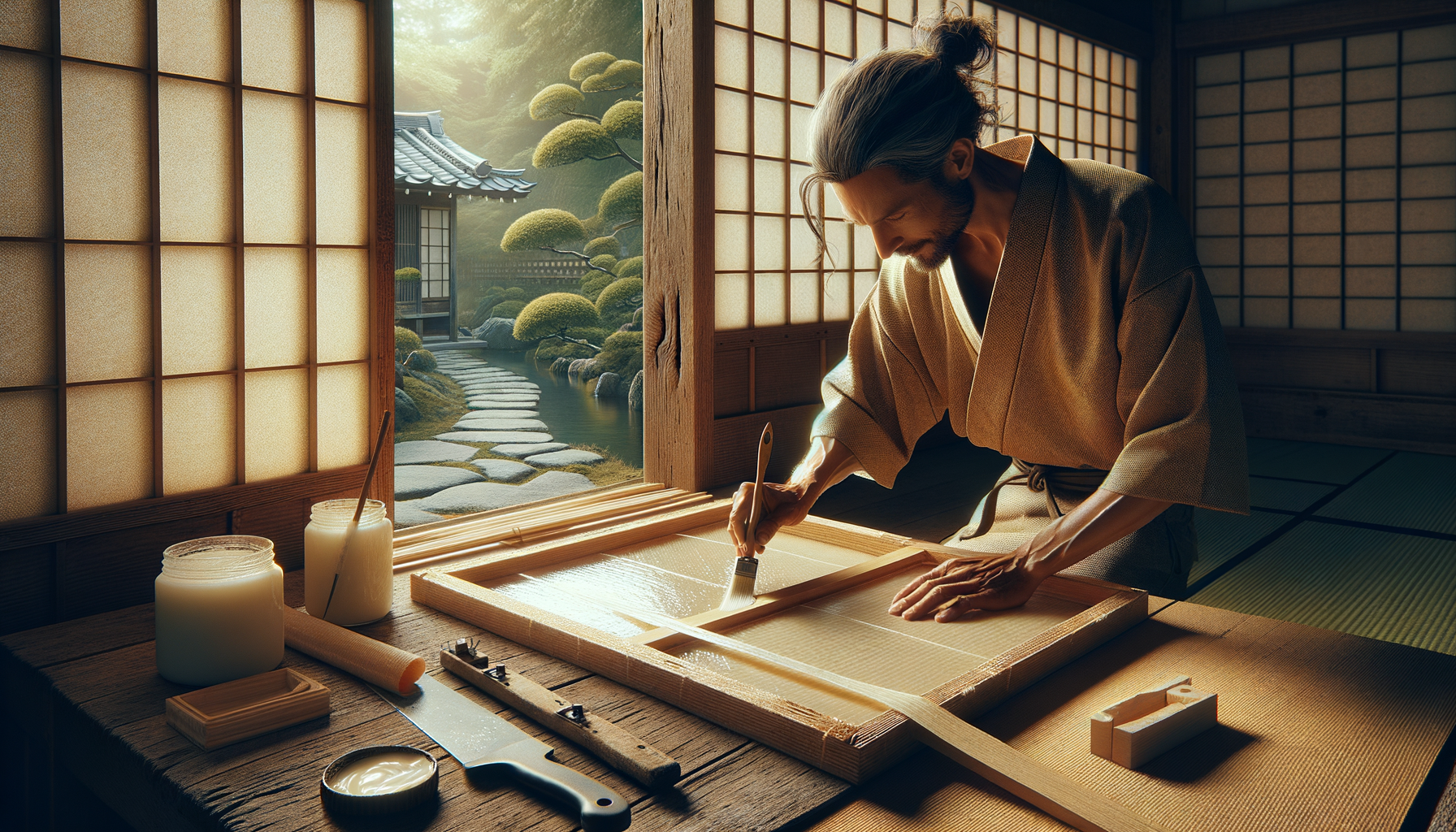Restoring the Elegance: A Comprehensive Guide to Repairing Japanese Shoji Screens
Understanding the Essence of Shoji Screens
Japanese shoji screens are more than mere functional elements; they embody the essence of traditional Japanese aesthetics and craftsmanship. These sliding doors or room dividers feature translucent washi paper panels within a meticulously crafted wooden frame, often made from cedar or cypress. The delicate washi paper, crafted from the long inner fibers of plants like kozo or gampi, allows diffused light to permeate the space, creating a serene and harmonious ambiance.
However, like all things of beauty, shoji screens are susceptible to the ravages of time. The delicate washi paper can become torn, discolored, or damaged, while the wooden frame may succumb to cracks, warping, or loose joints. Fortunately, with the right knowledge and techniques, these timeless pieces can be restored to their former glory, preserving their elegance and functionality for generations to come.
Assessing the Extent of Damage
Before embarking on the repair journey, a thorough assessment of the shoji screen’s condition is crucial. Carefully examine the wooden frame, looking for any cracks, warping, or loose joints that may compromise its structural integrity. Inspect the washi paper panels, noting any tears, discoloration, or missing sections that require attention.
It is essential to approach this assessment with a discerning eye, as the extent of the damage will dictate the appropriate course of action. Minor repairs may involve simple techniques, while more extensive damage may necessitate the replacement of specific components or even the entire frame.
Removing the Damaged Components
Once the damage has been thoroughly assessed, the next step is to carefully remove the damaged components. This process requires patience and a delicate touch to avoid further harm to the remaining intact sections.
- Removing the Washi Paper:
- If the paper is secured within the frame using intricate knots, gently untie them, taking care not to damage the surrounding paper or frame.
- If the paper is held in place by removable wood panels called kumiko, carefully remove these panels and set them aside, ensuring they remain undamaged for potential reuse.
- Repairing the Wooden Frame:
- For minor cracks or loose joints, utilize high-quality wood glue and clamps to secure the frame, ensuring proper alignment and a strong bond.
- In cases of severe damage, it may be necessary to replace the entire frame or specific sections. This task requires skilled craftsmanship and a deep understanding of traditional Japanese woodworking techniques.
Sourcing and Preparing the New Washi Paper
Obtaining high-quality washi paper is essential for a successful repair. Seek out reputable suppliers specializing in traditional Japanese materials to ensure the authenticity and longevity of the replacement paper.
When selecting the new washi paper, consider factors such as thickness, color, and texture to achieve the desired aesthetic and maintain consistency with the existing shoji or the overall design aesthetic of the space.
Once the appropriate washi paper has been procured, meticulously measure the dimensions of the shoji frame’s openings and cut the paper to size, allowing for a slight overlap to facilitate a secure installation. Attention to detail at this stage is crucial, as precise measurements will ensure a seamless and visually appealing result.
Installing the New Washi Paper: Embracing Traditional Techniques
The installation of the new washi paper is a delicate process that requires a deep understanding of traditional Japanese techniques. Depending on the original construction of the shoji screen, the paper can be secured using intricate knots or held in place by removable wood panels.
- Using Knots:
- If the original shoji employed knots, carefully follow the traditional knotting techniques to tie the new washi paper in place.
- Ensure that the knots are tight and secure, but not overly tightened, as this could tear the delicate paper.
- This intricate process demands patience and attention to detail, as each knot contributes to the overall structural integrity and aesthetic appeal of the shoji screen.
- Using Wood Panels:
- If the shoji utilized wood panels, gently insert the new washi paper between the frame and the panels, ensuring a snug fit.
- Secure the panels back in place, taking care not to crease or damage the delicate paper.
- This method allows for easier future repairs or replacements, as the paper can be accessed without compromising the integrity of the frame.
Whichever technique is employed, it is essential to approach the installation process with reverence and respect for the traditional methods, ensuring that the repaired shoji screen retains its authenticity and cultural significance.
Finishing Touches and Protective Measures
Once the new washi paper has been successfully installed, a few finishing touches can enhance the overall appearance and longevity of the repaired shoji screen.
- Trimming Excess Paper:
- Using a sharp utility knife or scissors, carefully trim any excess paper around the edges, ensuring a clean and precise finish.
- Applying a Protective Coating (Optional):
- To enhance the durability and longevity of the washi paper, consider applying a thin layer of protective coating, such as a clear acrylic sealer or traditional persimmon tannin solution.
- These coatings can help protect the delicate paper from environmental factors like moisture, UV rays, and general wear and tear, while maintaining the paper’s translucent quality.
It is important to note that the application of protective coatings should be done with caution and in accordance with traditional practices or expert guidance, as some coatings may alter the appearance or integrity of the washi paper.
Choosing the Right Adhesive for Shoji Repairs
When repairing the wooden frame or securing components, selecting the appropriate adhesive is crucial to ensure a strong and lasting bond. Traditional Japanese woodworking often favors the use of rice paste or wheat starch-based adhesives, which have been used for centuries and offer a natural and authentic approach.
However, for modern applications and convenience, there are several recommended options:
- White Carpenter’s Glue: This versatile wood glue is strong, dries clear, and is easy to work with, making it a suitable choice for shoji frame repairs and minor woodworking tasks.
- Epoxy Adhesive: For more substantial repairs or joining dissimilar materials, a two-part epoxy adhesive can provide a durable and long-lasting bond, ensuring the structural integrity of the repaired shoji screen.
- Hot Glue: While not a traditional choice, hot glue can be a quick and convenient option for securing washi paper or temporary repairs. However, it may not offer the same longevity as other adhesives and should be used judiciously.
When working with traditional Japanese materials and techniques, it is advisable to consult with experts or reference authentic sources to ensure the most appropriate and historically accurate methods are employed. This approach not only preserves the cultural significance of the shoji screen but also ensures the repair is executed with the utmost respect for the craft.
Maintaining the Beauty of Your Repaired Shoji
Once the repair process is complete, proper maintenance is essential to ensure the longevity and continued beauty of your shoji screen. Consider the following tips:
- Avoid direct sunlight exposure, as it can cause the washi paper to discolor or become brittle over time. Position the shoji screen in areas with diffused or indirect light.
- Maintain a consistent humidity level in the room, as extreme dryness or moisture can damage the paper and wooden components. Use a humidifier or dehumidifier as needed to maintain optimal conditions.
- Periodically dust or gently clean the shoji with a soft cloth or brush to remove any accumulated dirt or debris. Avoid using abrasive materials or harsh cleaning solutions that could damage the delicate paper or wood.
- Inspect the shoji regularly for any signs of damage or wear, and address any issues promptly to prevent further deterioration. Early intervention can often prevent the need for more extensive repairs.
By following these guidelines, you can preserve the beauty and functionality of your Japanese shoji screens, ensuring that they continue to enhance the aesthetic appeal and ambiance of your living or workspace for years to come.
Restoring and maintaining these timeless pieces is not just a practical endeavor but also a celebration of traditional Japanese craftsmanship and cultural heritage. By embracing the techniques and reverence for these ancient art forms, we can ensure that the elegance and serenity of shoji screens continue to grace our spaces, connecting us to the rich tapestry of Japanese tradition.
.
This article is generated by SafeComs AI, Automation Bot.





Leave a Reply